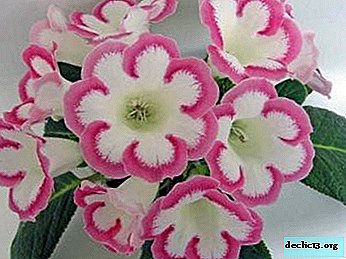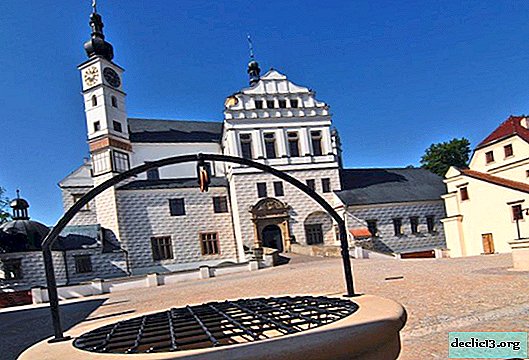Acquaintance with Rosalind gloxinia: photo, description and features of care

There are plants that attract attention at first glance. Gloxinia is just such a flower. She wins hearts with grace, refinement, unique brightness not only for flower lovers, but also for experienced gardeners. Seeing a flower, I immediately want to take it with me. But, like other excellent representatives of the flora, the plant has secrets that are important to know when growing.
In this article we will talk about how to grow this beautiful flower, what diseases can affect it and describe the features of its reproduction.
History and botanical description
At the end of the eighteenth century, sailors brought an interesting flower to our continent. the plant got its name, thanks to one of the participants of the expedition, a young doctor and lover of the beautiful, Benjamin Gloksin. Its homeland is considered the wild nature of Brazil, South America, Peru, the rocky terrain of Mexico. However, the story of gloxinia does not end there.
After a while, researchers in the field of botany discovered another flower with similar characteristics, but a different root system. Its name was “Sinningia”, in honor of William Sinning, a breeder from the University of Bonn. As it turned out later, gloxinia and synningia are one and the same plant. Through the efforts of this man, a variety of hybrid species and varieties appeared.
Gloxinia is a perennial plant with tuberous rhizome. The stalk is short, strong, fleshy. The foliage is bright green, velvety, oval in shape. Flowers distinguish by shape:
- conical;
- tubular;
- in the shape of a shoe;
- cup-shaped.
According to the texture of the flower: terry, semi-double, with a fringed edging. Colors are different, depending on the variety. Perhaps a combination of two shades at once.
Depending on the diameter of the sockets:
- standard over 25 cm;
- compact 15-25 cm;
- miniature 5-15 cm;
- micro gloxinia less than 5cm.
Features
Reference! In nature, there are approximately 25 species, all of them were bred from two main varieties: Gloxinia Beautiful and Royal.Among them, I want to highlight the Rosalind variety.
This beauty with an unusual name has a delicate and delicate aroma. The background of the buds is based on white with a raspberry fringing around the edge. Petals are large, wavy, conical in shape. One peduncle can accommodate more than 12 buds, around bright green leaves. The variety is compact in size. With proper care, Rosalind has abundant and prolonged flowering.
Photo
Check out the photo of Rosalind Gloxinia:





How and where to plant?
Potted flower requires soil renewal annually. The optimal time for planting is considered the end of February - the beginning of March. During this period, the vegetative process begins. Planting material should be young, dense, small in size, without mold and rot.
Previously, it is worth picking up containers for landing. Flowerpots should be small, if possible made of clay, with a drainage layer at the bottom of at least 2 cm. It is important that the soil in the pot is at room temperature and moist. It is necessary to plant the plant gently, directly with a lump of earth, sprinkled with fresh soil. However, without pressing or pressing strongly, as the planting material is fragile. Gloxinia tubers should be visible half out of the ground. At the end of the planting process, the plant should be moistened, but the main thing is not to pour.
Soil requirements
Usually the soil for the plant is slightly salted. To prepare it on your own, you should take part of the humus and twice as much deciduous land. All components to mix. In order to avoid the development of fungal diseases introduced into the soil, the components must be calcined for 30 minutes.
Important! The soil must be loose, breathable, enriched with micronutrients. Vermiculite and perlite are used as disintegrants.If it is not possible to prepare the soil with your own hands, you can purchase a soil mixture in garden shops.
Lighting
Like other gloxinia varieties, Rosalind is very fond of light, with the exception of penetrating sunlight. After all, they can leave burns on the leaves. Most of all, the plant prefers diffuse lighting.. It is allowed to leave gloxinia in partial shade, but at the same time the leaves can stretch.
For comfortable maintenance, begonia should be placed on windows facing east and west. On the north side, the sun is not enough, and on the south side it will be hot in summer. If there is enough light, the color of the flower will be dark green, the leaves in the rosettes will be horizontal, the stem will remain short. On the contrary, with a lack of lighting, the foliage grows vertically upward.
Care
To get good results when growing gloxinia, you must create the following conditions:
 The optimum temperature and humidity conditions in the room should be at the level of + 20-24 ° C, humidity 50-70%. In winter, it is important to reduce the temperature to + 15 ° C. However, it is during this period that you need to be careful, because the main fungal diseases develop in cold and moist soil.
The optimum temperature and humidity conditions in the room should be at the level of + 20-24 ° C, humidity 50-70%. In winter, it is important to reduce the temperature to + 15 ° C. However, it is during this period that you need to be careful, because the main fungal diseases develop in cold and moist soil.- Indoor flower is important to provide a 14-hour daylight. In the cold season, an additional light source is required.
- When moisturizing, you need to be careful enough that the liquid does not get on the plants. It is best to nourish the liquid by lowering the flowerpot into a container of water. In between watering, the topsoil should completely dry. It is advisable to take filtered water, without salts and impurities, slightly warmer than room temperature.
- From the beginning of spring to autumn, it is important to feed the flower. During the vegetative process, for active growth, fertilize with minerals containing nitrogen. Especially during the flowering period, apply fertilizers with a high content of potassium and phosphorus. With the onset of autumn, you should not feed.
- In summer, gloxinia is best placed on the balcony. Not bad, it relates to airing.
- If necessary, pick up dried flowers, loosen the soil, spray, remove dust from the leaves, inspect the plant for pests.
Diseases and harmful insects
Most often, flower troubles occur as a result of improper care. Especially harmful to the plant - excess moisture. After abundant hydration, fluid stagnation is possible. This leads to rotting of the root system, disruption in its operation, then the negative process spreads to the foliage. The leaves also begin to dry, rot. In such an environment, gray rot feels great. It is difficult to deal with this phenomenon, but it is possible. Apply special solutions of fungicides, as well as 1% Bordeaux liquid.
Attention! The increased humidity in the room and the complete absence of ventilation cause the development of powdery mildew, which is characterized by a white bloom on the begonia leaves.If measures are not taken in time, the plant, starting from the leaves, dries. With such misfortune it is necessary to fight with the help of fungicides.
Another disease of gloxinia is dangerous - root rot. Signs of it: the plant has brown spots, which soon become brown, and the inflorescences and shoots acquire a black color. The stalk rots at the base. The reasons for this are excess moisture or watering with cold water.
No less problems Rosalind can cause pests such as aphids, whiteflies, spider mites, thrips, caterpillars. The most effective way to combat them is with insecticides. It is also worth replanting the flower and changing the ground.
In order to avoid this kind of trouble, it is recommended to conduct a regular inspection, because it is easier to eliminate problems in the initial stages.
Breeding
Gloxinia are bred in these ways.:
- seeds;
- a sheet;
- cuttings;
- stepsons;
- peduncle;
- tuber division.
 The simplest and most proven method is the propagation of gloxinia with a leaf or cuttings.. It is quite easy to perform, plants take root with high probability. Also, these two methods make it possible to get a new flower, while retaining all the maternal signs: the old color, type of shoots.
The simplest and most proven method is the propagation of gloxinia with a leaf or cuttings.. It is quite easy to perform, plants take root with high probability. Also, these two methods make it possible to get a new flower, while retaining all the maternal signs: the old color, type of shoots.
Reproduction using seeds on their own, at home - a painstaking undertaking. Greenhouse conditions and a lot of time are needed for seed germination, rooting and picking seedlings. Therefore, the seed propagation method is applicable to flower farms.
Globinia perceives the tuberous method painfully, the result is not guaranteed, and it is also possible to harm the mother plant. However, this method has a place to be.
The option of propagation by a peduncle is not easy.but interesting at the same time. It does not injure plants, gives good results in the end.
If you properly organize care, follow all the rules - the result will certainly please. Gloxinia Rosalind will decorate the house with flowering and create a unique, pleasant atmosphere in it.
Useful video
Further, an informative video on the topic "Care for gloxinia at home":

 The optimum temperature and humidity conditions in the room should be at the level of + 20-24 ° C, humidity 50-70%. In winter, it is important to reduce the temperature to + 15 ° C. However, it is during this period that you need to be careful, because the main fungal diseases develop in cold and moist soil.
The optimum temperature and humidity conditions in the room should be at the level of + 20-24 ° C, humidity 50-70%. In winter, it is important to reduce the temperature to + 15 ° C. However, it is during this period that you need to be careful, because the main fungal diseases develop in cold and moist soil.















